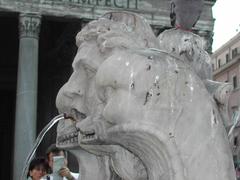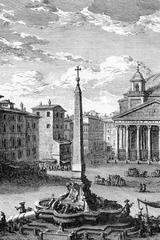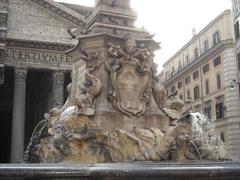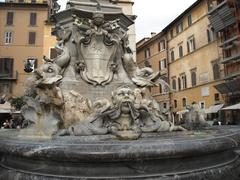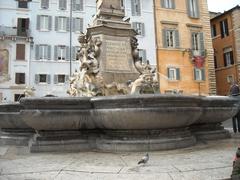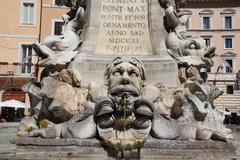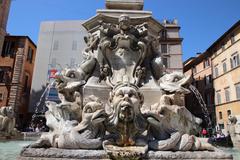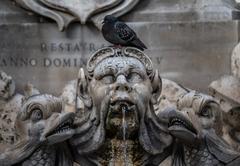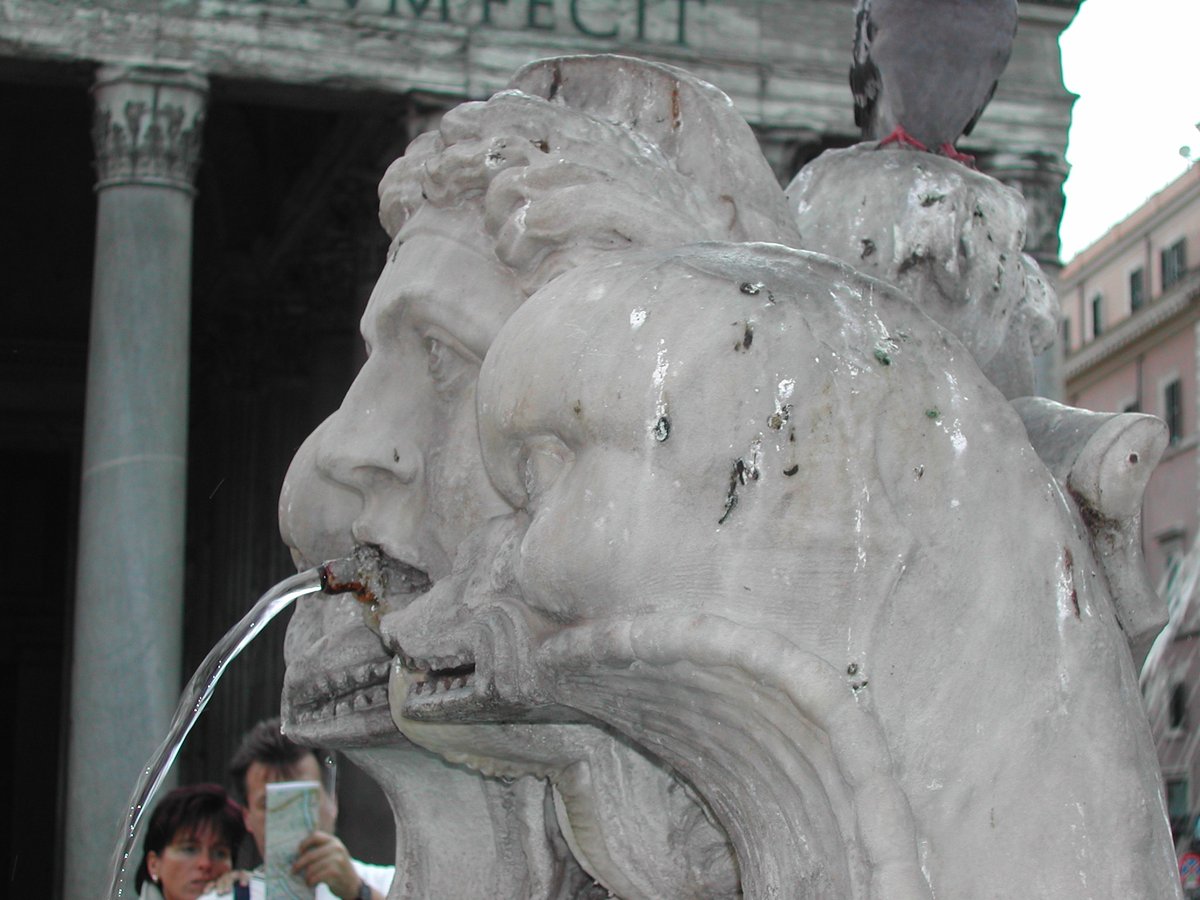
Fountain of the Pantheon Rome: Visiting Hours, Tickets, and Historical Sites Guide
Date: 14/06/2025
Introduction
The Fountain of the Pantheon stands as a striking emblem of Rome’s artistic legacy and urban vitality. Positioned in Piazza della Rotonda, directly before the Pantheon, this Renaissance-Baroque fountain weaves together Egyptian symbolism, Renaissance design, and Baroque grandeur. Commissioned in 1575 by Pope Gregory XIII and designed by Giacomo della Porta, the fountain later gained even greater prominence with the placement of the ancient Egyptian Obelisco Macuteo in 1711 under Filippo Barigioni. Today, it is both a beloved meeting place and a living testament to Rome’s capacity for renewal and adaptation (Turismo Roma; The Geographical Cure).
Accessible 24 hours a day with no admission fee, the fountain is a nexus for locals and travelers alike. Its waters, supplied by the ancient Acqua Vergine aqueduct, continue to link the present to Rome’s classical past. Whether you’re seeking artistic inspiration, historical insight, or a vibrant urban experience, the Fountain of the Pantheon is a must-see on any Roman itinerary (rome.us; The Tourist Checklist).
Table of Contents
- Introduction
- Historical Background and Artistic Significance
- Practical Visitor Information
- Artistic Features & Materials
- Recent Restoration
- Frequently Asked Questions (FAQ)
- Timeline of Key Events
- Notable Facts and Figures
- Conclusion
- References
Historical Background and Artistic Significance
Origins and Construction
The Fontana del Pantheon was commissioned in 1575 as part of an ambitious campaign to restore Rome’s grandeur through public works. Following the revival of the Aqua Virgo aqueduct, fresh water once again flowed into central Rome, enabling the creation of new fountains (RomeWise). Giacomo della Porta, a prominent architect, designed the fountain’s original basin and dolphin motifs, while Leonardo Sormani executed the marble work in 1576. The fountain formed part of a broader papal initiative to beautify Rome and provide essential infrastructure (Rome Vacation Tips).
Baroque Enhancements and the Obelisk
In 1711, under Pope Clement XI, Filippo Barigioni reimagined the fountain, adding the Obelisco Macuteo—a genuine Egyptian obelisk from the reign of Ramses II, transferred to Rome in ancient times. Barigioni’s redesign enlarged the basin and repositioned four dolphins to support the obelisk, blending Renaissance symmetry with Baroque spectacle (Rome Vacation Tips). This juxtaposition of antiquity and modernity illustrates Rome’s unique approach to layering history within its urban environment.
Symbolism and Urban Role
The fountain is more than a decorative element; it is a visible sign of papal patronage, civic pride, and the Christianization of ancient symbols. The papal coat of arms adorns the base, while the obelisk’s hieroglyphs and the dolphins’ playful forms echo Rome’s long-standing relationship with water and its cosmopolitan heritage. Today, a fontanella beside the fountain still dispenses potable water from the ancient aqueduct, connecting visitors to a tradition that spans millennia (rome.us).
Practical Visitor Information
Visiting Hours & Admission
- Fountain Access: Open 24/7, free of charge.
- Pantheon Entry: The Pantheon requires a ticket and is typically open from 9:00 AM to 7:00 PM; verify current hours before visiting.
Directions & Accessibility
- Location: Piazza della Rotonda, Rome.
- Metro: Line A to Barberini, then a 10-minute walk.
- Bus: Routes 62, 63, 64, and others stop nearby.
- On Foot: Easily walkable from Piazza Navona, Trevi Fountain, and other central landmarks.
- Accessibility: Piazza is largely pedestrian and wheelchair accessible, though cobblestones may present challenges.
Optimal Visiting Times
- Best Hours: Early mornings or late evenings for fewer crowds and atmospheric lighting.
- Tips: June is busy; evenings offer a more tranquil experience (Rome Actually).
Nearby Attractions
- Pantheon: Directly adjacent; entry ticket required.
- Piazza Navona: Short walk; home to other famous fountains.
- Campo de’ Fiori: Bustling market and nightlife.
- Church of Santa Maria Sopra Minerva: Gothic church with notable art.
- San Luigi dei Francesi: Caravaggio masterpieces.
- Largo di Torre Argentina: Ancient temples and a cat sanctuary.
- Trevi Fountain, Spanish Steps, Via del Corso: All within walking distance.
Artistic Features & Materials
Combining Renaissance and Baroque elements, the fountain features a travertine basin, four marble dolphins, and the red granite Obelisco Macuteo (6.34 meters tall). The dolphin figures, papal coat of arms, and water motifs symbolize life, purification, and the city’s enduring creativity. The original marble figures are preserved in the National Museum of Rome, with replicas on the fountain (The Geographical Cure).
Recent Restoration
The fountain has undergone several restorations, most recently in 2024 as part of the Caput Mundi conservation initiative, ahead of the Vatican’s Jubilee Year 2025. This comprehensive project included marble cleaning, structural repairs, and restoration of water features, ensuring the fountain’s preservation for future generations (Euro Weekly News).
Frequently Asked Questions (FAQ)
Q: What are the Fountain of the Pantheon’s visiting hours?
A: The fountain is outdoors and accessible at all hours.
Q: Is there a fee to visit the fountain?
A: No, it’s free to visit.
Q: Are guided tours available?
A: Yes, many walking tours include the fountain and the Pantheon.
Q: Is the fountain accessible for wheelchair users?
A: The piazza is accessible, but cobblestones and steps around the fountain may pose challenges.
Q: What is the best time to visit?
A: Early mornings or late evenings, especially during the busy summer months.
Timeline of Key Events
- 19 BCE: Construction of Aqua Virgo aqueduct.
- 1575–1576: Fountain commissioned and built by della Porta and Sormani.
- 1711: Barigioni redesigns the fountain, adds the obelisk.
- 1866: Original marble figures replaced with replicas.
- 1992 & 2024: Major restorations, latest as part of the Caput Mundi scheme (Euro Weekly News).
Notable Facts and Figures
- Obelisk Height: 6.34 meters (20.8 feet)
- Architects: Giacomo della Porta; Filippo Barigioni (Baroque restorer)
- Water Source: Acqua Vergine aqueduct
- Accessibility: Pedestrian piazza, partial wheelchair access
- Best Visiting Times: Early morning or late evening
Conclusion
The Fountain of the Pantheon is a microcosm of Rome itself—layered, artistic, and accessible. Its blend of ancient, Renaissance, and Baroque elements, coupled with a vibrant urban setting, makes it an essential stop for any visitor. Plan your visit around quieter hours, explore nearby attractions, and immerse yourself in Rome’s living history.
For more tips, guided audio tours, and the latest on Rome’s historical sites, download the Audiala app and follow us on social media.
References
- Fontana del Pantheon, 2024, Wikipedia
- Fountain of the Pantheon, 2024, Turismo Roma
- Guide to the Pantheon, 2024, The Geographical Cure
- Fountain of the Pantheon, 2024, Rome.us
- Rome’s Iconic Fountains Restored and Back in Action, 2024, Euro Weekly News
- Fountain of the Pantheon, 2024, Rome Vacation Tips
- Visiting the Pantheon in Rome, 2024, Rome Actually
- The Pantheon Fountain, 2024, Nelmitravel
- Fountain of the Pantheon, 2024, The Tourist Checklist
- Pantheon and Surroundings, 2024, Rome.info
